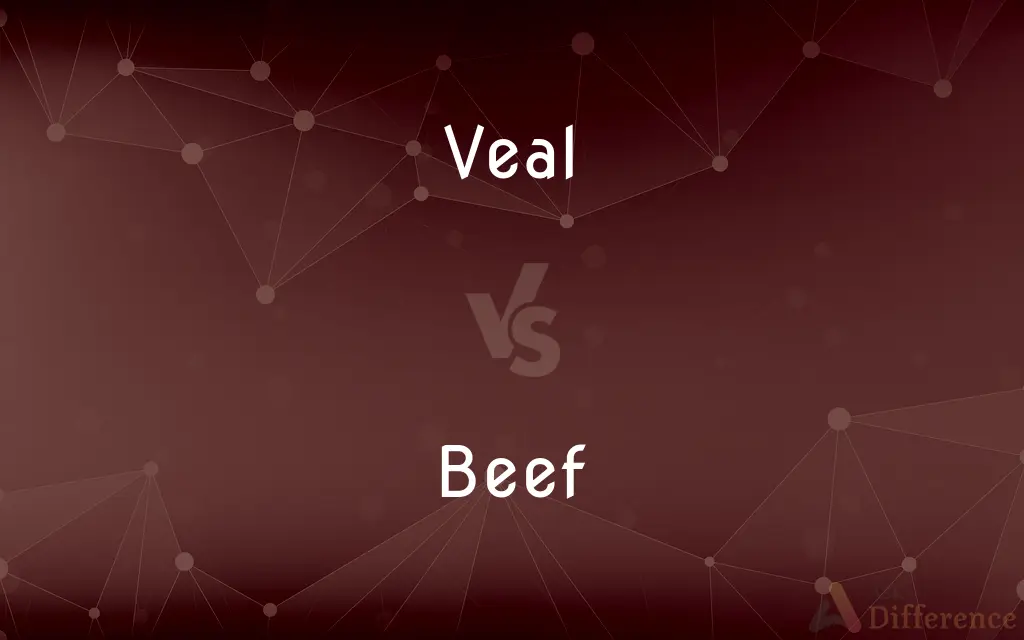Veal vs. Beef — What's the Difference?
Edited by Tayyaba Rehman — By Fiza Rafique — Updated on October 30, 2023
Veal is meat from young calves, typically under 20 weeks old, while beef comes from mature cattle. The age difference gives veal its tender texture and pale color compared to the darker, firmer beef.

Difference Between Veal and Beef
Table of Contents
ADVERTISEMENT
Key Differences
Veal and Beef are both meat products derived from cattle, but they differ considerably in their source and characteristics. Veal, in essence, is the meat that comes from young calves, typically those that are under 20 weeks of age. It's prized for its tender texture and light color, which distinguishes it from other meats. On the other hand, beef is obtained from mature cattle that can range in age, often between 18 months to 2 years or more. The age difference inherently affects the texture and taste of the meat.
When discussing the culinary properties of Veal, chefs and gourmets often highlight its mild flavor and soft, delicate texture. Because of the age of the calves, their meat hasn't developed the robust flavor or the firmer texture that's characteristic of beef. As a result, veal is often used in dishes that require a subtle meat flavor. Beef, with its deeper flavor profile and firmer texture, is more versatile in cooking, suitable for everything from steaks to stews.
The nutritional differences between Veal and Beef also stand out. While both types of meat offer essential nutrients like protein, iron, and certain vitamins, veal generally has a more delicate fat content and can be leaner than beef. In contrast, beef, particularly certain cuts, can have marbling or intramuscular fat, which is often associated with richer flavor and juiciness.
Ethically, the production of Veal has been a topic of debate in animal welfare discussions. The conditions in which some veal calves are raised have raised concerns among animal rights advocates. Beef production, while also debated in terms of environmental and ethical implications, is generally perceived differently than veal due to differences in cattle-raising practices.
Comparison Chart
Source
Meat from young calves, usually under 20 weeks old.
Meat from mature cattle, typically 18 months to 2+ years.
ADVERTISEMENT
Texture
Tender and soft.
Firmer, can vary depending on the cut and age.
Color
Pale, ranging from white to light pink.
Darker, from deep pink to red.
Flavor
Mild flavor.
Rich and robust flavor.
Nutritional Content
Often leaner with a delicate fat content.
Can be marbled; richer in fats depending on the cut.
Compare with Definitions
Veal
Meat from young calves, often under 20 weeks.
She prepared a delicious veal piccata for dinner.
Beef
Meat from mature cattle, used in various culinary dishes.
The beef stew simmered all afternoon.
Veal
A type of meat often associated with certain European dishes.
The veal marsala was her favorite dish at the bistro.
Beef
A type of red meat with a robust flavor.
She grilled the beef steaks to medium-rare.
Veal
Calf meat considered a delicacy in many cuisines.
He ordered the veal scallopini at the Italian restaurant.
Beef
A common protein source in many cultures and cuisines.
His favorite dish was beef and broccoli stir-fry.
Veal
A tender and pale-colored meat, distinct from mature beef.
The veal cutlets were cooked to perfection.
Beef
Meat from cattle, often categorized by cuts like sirloin or ribeye.
She ordered the beef tenderloin at the steakhouse.
Veal
Young beef, prized for its soft texture.
For her gourmet meal, she chose a veal roast.
Beef
Beef is the culinary name for meat from cattle, particularly skeletal muscle. Humans have been eating beef since prehistoric times.
Veal
Veal is the meat of calves, in contrast to the beef from older cattle. Veal can be produced from a calf of either sex and any breed; however, most veal comes from young males of dairy breeds which are not used for breeding.
Beef
The flesh of a cow, bull, or ox, used as food
Beef cattle
There was the smell of roast beef
Veal
The meat of a calf.
Beef
Flesh with well-developed muscle
He needs a little more beef on his bones
Veal
Also veal·er (vēlər) A calf raised to be slaughtered for food.
Beef
A complaint or grievance
He has a beef with education: it doesn't teach the basics of investing
Veal
The flesh of a calf (i.e. a young bovine) used for food.
Beef
A criminal charge
Getting caught with pot in the sixties was a narco beef
Veal
The female genitalia. en
Beef
Complain
He was beefing about how the recession was killing the business
Veal
To raise a calf for meat production.
Beef
A full-grown steer, bull, ox, or cow, especially one intended for use as meat.
Veal
The flesh of a calf when killed and used for food.
Beef
The flesh of a slaughtered full-grown steer, bull, ox, or cow.
Veal
Meat from a calf
Beef
(Informal) Human muscle; brawn.
Beef
Pl. beefs Slang A complaint.
Beef
To complain.
Beef
(uncountable) The meat from a cow, bull, or other bovine.
I love eating beef.
Beef
The edible portions of a cow (including those which are not meat).
Lean finely textured beef
Boneless lean beef trimmings
Beef
Muscle or musculature; size, strength or potency.
Put some beef into it! We've got to get the car over the bump.
We've got to get some beef into the enforcement provisions of that law.
Beef
Essence, content; the important part of a document or project.
The beef of his paper was a long rant about government.
Beef
(uncountable) Bovine animals.
Beef
A bovine (cow or bull) being raised for its meat.
Do you want to raise beeves?
Beef
A grudge; dislike (of something or someone); lack of faith or trust (in something or someone); a reason for a dislike or grudge. (often + with)
He's got beef over what you said.
He's got a beef with everyone in the room.
Remember what happened last fall? That's his beef with me.
Beef
(Dorset) Fibrous calcite or limestone, especially when occurring in a jagged layer between shales in Dorset.
Beef
To complain.
Beef
To add weight or strength to.
Beef
To fart; break wind.
Ugh, who just beefed in here?
Beef
To feud or hold a grudge against.
Those two are beefing right now
– best you stay out of it for now.
Beef
To cry.
David was beefing last night after Ruth told him off.
Beef
To fail or mess up.
I beefed my presentation hard yesterday.
Beef
Being a bovine animal that is being raised for its meat.
We bought three beef calves this morning.
Beef
Producing or known for raising lots of beef.
Beef farms
Beef country
Beef
Consisting of or containing beef as an ingredient.
Beef stew
Beef
(slang) beefy; powerful; robust.
Wow, your audio setup is beef!
Beef
An animal of the genus Bos, especially the common species, Bos taurus, including the bull, cow, and ox, in their full grown state; esp., an ox or cow fattened for food.
A herd of beeves, fair oxen and fair kine.
Beef
The flesh of an ox, or cow, or of any adult bovine animal, when slaughtered for food.
Beef
Applied colloquially to human flesh.
Beef
Of, pertaining to, or resembling, beef.
Beef
Cattle that are reared for their meat
Beef
Meat from an adult domestic bovine
Beef
Informal terms for objecting;
I have a gripe about the service here
Beef
Complain;
What was he hollering about?
Beef
Meat that can vary in texture and marbling based on the cut.
The marbled beef was perfect for barbecuing.
Common Curiosities
Is veal considered more tender than beef?
Generally, yes, veal is softer and more tender than beef.
What is the primary difference between veal and beef?
Veal is meat from young calves, while beef is from mature cattle.
Which has a richer flavor, veal or beef?
Beef usually has a deeper, more robust flavor than veal.
Can you substitute beef for veal in recipes?
While possible, it might alter the dish's taste and texture.
Which is more expensive generally, veal or beef?
Often, veal is pricier than beef due to its specialized production.
Can I find both veal and beef at most supermarkets?
While beef is commonly available, veal might be at specialized or larger stores.
Why is veal lighter in color compared to beef?
Veal's pale color is due to the age of the calf and its diet.
Are there specific cooking methods best suited for veal?
Veal is often pan-fried, sautéed, or roasted, given its tenderness.
Are there ethical concerns associated with veal production?
Yes, some practices in veal production have raised animal welfare concerns.
Which is leaner: veal or beef?
Veal is often leaner, but it depends on the specific cut and preparation.
Why is beef marbled?
Marbling refers to the fat streaks in beef, enhancing flavor and tenderness.
How can I identify quality beef cuts?
Look for beef with good marbling, a fresh smell, and a vibrant color.
How are beef cattle raised differently from veal calves?
Beef cattle are raised to mature, while veal calves are harvested young.
What cuisines prominently feature veal dishes?
Italian, French, and other European cuisines often have veal dishes.
Is there a health difference between consuming veal and beef?
Both offer essential nutrients; veal might be leaner while beef can be richer in fats.
Share Your Discovery

Previous Comparison
Underarm vs. Armpit
Next Comparison
Guaranty vs. GuaranteeAuthor Spotlight
Written by
Fiza RafiqueFiza Rafique is a skilled content writer at AskDifference.com, where she meticulously refines and enhances written pieces. Drawing from her vast editorial expertise, Fiza ensures clarity, accuracy, and precision in every article. Passionate about language, she continually seeks to elevate the quality of content for readers worldwide.
Edited by
Tayyaba RehmanTayyaba Rehman is a distinguished writer, currently serving as a primary contributor to askdifference.com. As a researcher in semantics and etymology, Tayyaba's passion for the complexity of languages and their distinctions has found a perfect home on the platform. Tayyaba delves into the intricacies of language, distinguishing between commonly confused words and phrases, thereby providing clarity for readers worldwide.
















































